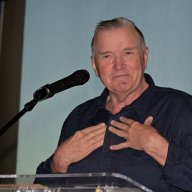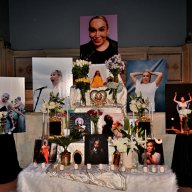Roughly 50 people held a vigil in Midtown Manhattan near Iran’s Mission to the United Nations to mark the one-year anniversary of the hanging of two Iranian teenagers who were killed, participants said, because they were gay.
“We need to show solidarity,” said Frank Jump, a teacher and longtime gay and AIDS activist, at the July 19 event. The Manhattan vigil was one of at least 27 that were held around the globe to mark the executions.
The killings of Ayaz Marhoni, 18, and Mahmoud Asgari, whose age was given as 16 or 17 in 2005 press reports, were illustrated with gruesome photos that some gay groups sent around the globe last year. The photos were cited as evidence of the Iranian government’s continued attacks on gay people in that country.
One vigil participant brought an enlarged version of one photo showing Marhoni and Asgari just moments before their deaths, hooded with their hands bound, as the nooses were being placed around their necks. The text below the photo read, “Iran Stop Killing Gays.”
Human rights groups that oppose the death penalty, such as Amnesty International, Human Rights Watch (HRW), and the International Gay and Lesbian Human Rights Commission (IGLHRC), disputed the assertion that the boys were killed because they were gay.
Scott Long, director of HRW’s Lesbian, Gay, Bisexual and Transgender Rights Project, noted last year that it was “reasonably certain” that Marhoni and Asgari were executed for sexual assault on a 13-year-old boy.
IGLHRC was the original organizer and a sponsor of the July 19 New York City vigil, but pulled its support on July 14 leaving some activists to put the event together in five days. Instead IGLHRC and HRW organized a July 19 panel discussion on gays in Iran at the Lesbian, Gay, Bisexual and Transgender Community Center. Roughly 50 people attended that event as well.
The Iranian expatriate community and gays in Iran appear to be divided over the vigils with some groups or individuals endorsing them and others opposing them. One vigil organizer disparaged the panel discussion.
“The Iranian Mission doesn’t give a damn about a bunch of people sitting in a room in Greenwich Village,” he said. Speakers at the vigil also noted the controversy.
“These boys were not pedophiles,” said Reverend Pat Bumgardner, pastor of the Metropolitan Community Church of New York, a gay denomination. “They were kids who found love…They were victims of a hate crime and of state-sanctioned murder.”
The vigils, which were promoted by Outrage!, a British organization that first broke the news of the hangings last year, endorsed five points—an end to executions in Iran, an end to the arrests, torture, and imprisonment of Iranian queers and the decriminalization of same-sex relationships there, an end to the deportation back to Iran of queer Iranian asylum-seekers, support for democracy in Iran, and opposition to military intervention there.
“I’m opposing the killing of gays in Iran,” said Jessie Daniels, a professor at Hunter College, at the vigil. “I’m also demanding that the U.S. stop sending gays back to Iran where they will surely be killed.”
Joining the vigil was Jonathan Tasini, a candidate for the Democratic nomination for U.S. Senate and Mark Green, a candidate for the Democratic nomination for state attorney general.
Tasini noted the five demands and said, “We’re not standing here trying to encourage the U.S. to invade Iran.” Senator Hillary Clinton, Tasini’s opponent, supported the U.S. invasion of Iraq.
Green told the crowd, “History is an eternal contest between hate and hope. Right now hate is winning in the Middle East.” Green noted the controversy surrounding the vigils and said, while the vigil would likely not stop the Iranian government, “If we don’t speak here today, it’s more likely they will continue… I know if we don’t speak we will not be heard.”
—Duncan Osborne
gaycitynews.com


































